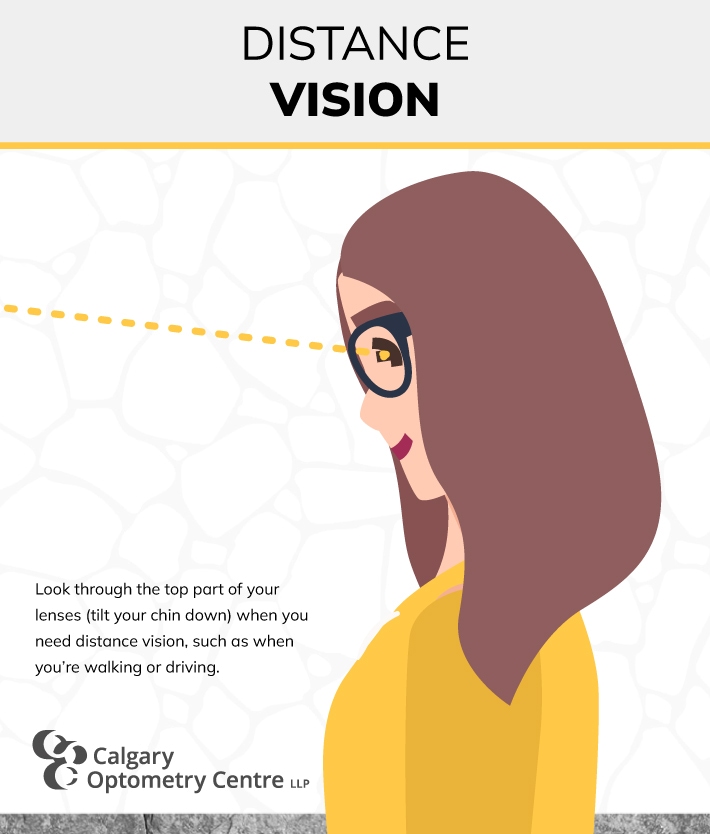With so many options for frames and lenses, how do you choose the right lenses for your needs? For those who experience multiple refractive errors at the same time, it might be important to choose lenses that can correct your vision at multiple distances—such as progressive lenses.
When you first start using progressive lenses, you may experience eye strain as your eyes learn how to adjust to switching between focal distances. Over time, as you train your eyes and you get used to your new lenses, the eye strain you experience from your glasses should go away.
If you do experience prolonged eye strain after switching lenses, schedule a visit to your optometrist. Your lenses might not have the right prescription for your needs, and looking through lenses with the wrong prescription can cause eye strain.
How Do Progressive Lenses Work?
Progressive lenses have multiple zones of focal strength. The zones gradually change prescription from top to bottom, so you can see clearly at different distances by looking through different parts of the lens.
Progressives are a type of specialty lens meant to help those experiencing simultaneous refractive issues, like myopia (nearsightedness) and presbyopia (age-related farsightedness). By incorporating different prescription strengths, progressives help people see clearly up close and far away without the need for a second pair of glasses.
Are Progressive Lenses the Same as Bifocals?
Progressive lenses are similar to bifocal lenses, but they are not the same. While both types of lenses can provide clear vision at multiple distances, the change in prescription you experience with progressive lenses is less seamless.
Bifocal lenses have a solid, thin line that separates the different focal zones. Progressive lenses do not have a solid separation—the transition between focal lengths is subtle and gradual.
Sometimes, bifocal lenses can create what’s known as an “image jump” effect, where something you’re looking at seems to change in position and clarity as your eyes move between focal zones. Progressives are designed to reduce that effect and make the transition between focal zones less obvious.
What Are the Pros & Cons of Progressive Lenses?
Progressives can be a great option for many people, especially older adults affected by presbyopia. It’s important to know about both the pros and cons so you can make an informed decision about which lenses are right for you.
Pros:
The pros of progressive lenses include the following:
- Support for visual clarity at multiple distances with 1 pair of glasses
- A seamless design without an obvious solid line
- Customizable focal zones for different vision and lifestyle needs
Cons:
The cons of progressive lenses include the following:
- An adjustment period during which you may experience eye strain
- The need to train your eyes to use the lenses effectively
- Potential costs may be higher than single-vision lenses
It’s not always easy to determine if progressive lenses are right for you. Fortunately, during an eye exam, your optometrist can evaluate your vision needs and lifestyle to find you the right type of frames and lenses.
In some cases, the savings of reducing your need for multiple pairs of glasses may help offset the cost of choosing progressive lenses, but each person is different. The cost of your glasses can vary based on your prescription and your chosen frames—in addition to the lenses you choose.



How Long Does It Take to Get Used to Progressive Lenses?
It can take anywhere between a week to a few months to get used to progressive lenses. During that time, you may experience eye strain or tired eyes. If your eyes start feeling sore when you wear new progressive lenses, you can take a break by switching to different lenses temporarily.
The exact amount of time it takes your eyes to adjust can depend on how much you wear your progressive lenses and whether your glasses were properly fitted and adjusted by an optometrist or optician.
How Do You Train Your Eyes to Use Progressive Lenses?
When you first start using progressive lenses, focus on pointing your nose toward the object you want to look at, then tilt your chin up or down to look through different parts of the lens and bring that object into focus.
As you get used to looking through different parts of your lenses, it can become easier to use your lenses without focusing on making pronounced movements and adjustments to your posture.
When you use progressive lenses, you may also notice that you experience vision distortion or feel off-balance when moving your eyes from side to side. Peripheral vision distortion is normal with progressives, and the sensation of feeling off-balance should get better as you get used to your new lenses.
Can Progressive Lenses Help with Digital Eye Strain?
Yes! In some cases, progressive lenses can help with digital eye strain through specific adjustments and focal customization options for computer and screen use. There is a special variety of progressive lenses known as computer lenses or computer glasses.
Computer lenses are adjusted specifically for focusing on computer screens—which are typically around arm’s length from your face. For some people, using computer glasses can reduce digital eye strain and make it easier to switch between different visual tasks.
It’s important to note that computer glasses with progressive lenses are different from blue light glasses, which can also reduce the effects of computer screens on your eyes.

Let’s Talk About Your Vision Needs
You have options for seeing clearly at different distances, and we want to help you find glasses and lenses that not only meet your vision needs but also fit your lifestyle. At Calgary Optometry Centre, we’ve followed a single mission since 1982: to take great care of our patients.Schedule an appointment today to discuss your vision and find the right lenses for your needs.




